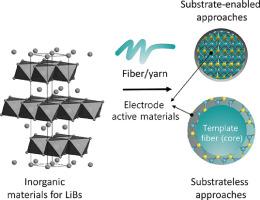Energy Storage Materials ( IF 18.9 ) Pub Date : 2021-08-31 , DOI: 10.1016/j.ensm.2021.08.039 Ifra Marriam 1 , Mike Tebyetekerwa 2 , Zhen Xu 3 , Hiran Chathuranga 1 , Su Chen 1 , Hao Chen 1 , Jun-Chao Zheng 4 , Aijun Du 5 , Cheng Yan 1

|
Next-generation electronics will be driven by miniaturized components tuned for wearable options, which will have the capability to provide humans and their environment with state-of-the-art connectivity and monitoring in the so-called internet of things (IoT) environment. These wearable and textile-based electronic devices (including sensors, controllers, displays, and many others) will need to be powered like other traditional electronics. And, one of the most innovative ways to do so is by designing textile and yarn-based batteries. To this date, lithium-ion batteries (LiBs) power the highest percentage of consumer electronics as a proven source of energy, albeit with some shortcomings like a limited lifetime, safety, and cost concerns. The high-performance LiBs can be realized using diverse inorganic nano materials as active materials in their electrodes. In this work, we have dedicated our efforts to describing, reviewing, and proposing the possible methods that can be employed to translate the complex existing inorganic materials for LiB electrodes into textile electrodes and their further assembly into compatible all-textile wearable LiBs. Extra efforts have been taken to describe most of the involved textile-related technologies in terms of their merits and demerits across the report. Finally, a broader perspective and conclusion have been drawn for this particular space of research.
中文翻译:

使无机材料成为可穿戴纤维/纱线和柔性锂离子电池的技术
下一代电子产品将由针对可穿戴选项进行调整的小型化组件驱动,这些组件将能够在所谓的物联网 (IoT) 环境中为人类及其环境提供最先进的连接和监控。这些可穿戴和基于纺织品的电子设备(包括传感器、控制器、显示器等)将需要像其他传统电子设备一样供电。而且,最具创新性的方法之一是设计基于纺织品和纱线的电池。迄今为止,锂离子电池 (LiBs) 作为一种经过验证的能源,为消费电子产品的比例最高,尽管存在一些缺点,例如有限的使用寿命、安全性和成本问题。可以使用多种无机纳米材料作为电极中的活性材料来实现高性能 LiB。在这项工作中,我们致力于描述、审查和提出可能的方法,这些方法可用于将用于 LiB 电极的复杂现有无机材料转化为纺织电极,并将它们进一步组装成兼容的全纺织可穿戴 LiB。在整个报告中,我们已经采取额外的努力来描述大多数涉及的纺织相关技术的优缺点。最后,针对这一特定研究空间得出了更广泛的观点和结论。并提出了可能的方法,这些方法可用于将用于 LiB 电极的复杂的现有无机材料转化为纺织电极,并将它们进一步组装成兼容的全纺织可穿戴 LiB。在整个报告中,我们已经采取额外的努力来描述大多数涉及的纺织相关技术的优缺点。最后,针对这一特定研究空间得出了更广泛的观点和结论。并提出了可能的方法,这些方法可用于将用于 LiB 电极的复杂的现有无机材料转化为纺织电极,并将它们进一步组装成兼容的全纺织可穿戴 LiB。在整个报告中,我们已经采取额外的努力来描述大多数涉及的纺织相关技术的优缺点。最后,针对这一特定研究空间得出了更广泛的观点和结论。











































 京公网安备 11010802027423号
京公网安备 11010802027423号